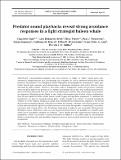Files in this item
Predator sound playbacks reveal strong avoidance responses in a fight strategist baleen whale
Item metadata
| dc.contributor.author | Cure, Charlotte | |
| dc.contributor.author | Doksaeter-Sivle, Lise | |
| dc.contributor.author | Visser, Fleur | |
| dc.contributor.author | Wensveen, Paulus Jacobus | |
| dc.contributor.author | Isojunno, Saana | |
| dc.contributor.author | Harris, Catriona M | |
| dc.contributor.author | Kvadsheim, Petter | |
| dc.contributor.author | Lam, Frans-Peter | |
| dc.contributor.author | Miller, Patrick | |
| dc.date.accessioned | 2020-04-21T23:32:06Z | |
| dc.date.available | 2020-04-21T23:32:06Z | |
| dc.date.issued | 2015-04-22 | |
| dc.identifier | 156503580 | |
| dc.identifier | 1ec079a7-ef93-4c18-adc0-7a8624c9f605 | |
| dc.identifier | 84928343342 | |
| dc.identifier | 000354394900021 | |
| dc.identifier.citation | Cure , C , Doksaeter-Sivle , L , Visser , F , Wensveen , P J , Isojunno , S , Harris , C M , Kvadsheim , P , Lam , F-P & Miller , P 2015 , ' Predator sound playbacks reveal strong avoidance responses in a fight strategist baleen whale ' , Marine Ecology Progress Series , vol. 526 , pp. 267-282 . https://doi.org/10.3354/meps11231 | en |
| dc.identifier.issn | 0171-8630 | |
| dc.identifier.other | ORCID: /0000-0002-2212-2135/work/37031852 | |
| dc.identifier.other | ORCID: /0000-0001-9198-2414/work/60887690 | |
| dc.identifier.uri | https://hdl.handle.net/10023/19835 | |
| dc.description.abstract | Anti-predator strategies are often defined as ‘flight’ or ‘fight’, based upon prey anatomical adaptations for size, morphology and weapons, as well as observed behaviours in the presence of predators. The humpback whale Megaptera nova eangliae is considered a ‘fight’ specialist based upon anatomy and observations of grouping behaviour and active defence when attacked by killer whales. However, the early stage of humpback whale anti-predator strategy, when the prey detects the presence of a distant potential predator that may not have perceived it, has never been described. Our aim was to experimentally examine this initial stage of anti-predator responses. Humpbacks are likely to hear well at the frequencies of killer whale vocalisations, thus the perception of killer whale sounds could trigger anti-predator responses. To address this hypothesis, we played mammal-eating killer whale sounds to 8 solitary or paired humpback whales in North Atlantic feeding grounds and monitored their behavioural responses. We found that predator sound playbacks induced a cessation of feeding, a change in the diving pattern and a clear directional and rapid horizontal avoidance away from the speaker. Interestingly, in mothercalf pairs with young calves, the directional horizontal avoidance was atypically alternated by 90 degree turns, which may serve as a mechanism to better track the pre dator or a stealth tactic when more vulnerable animals are present. These results provide experimental evidence that humpback whales can exhibit a strong horizontal avoidance as an initial stage of anti-predator defence, indicating that anti-predator responses may be more graded and mixed than previously recognized. | |
| dc.format.extent | 209478 | |
| dc.format.extent | 658602 | |
| dc.language.iso | eng | |
| dc.relation.ispartof | Marine Ecology Progress Series | en |
| dc.subject | Anti-predator strategy | en |
| dc.subject | Predator sound playbacks | en |
| dc.subject | Multi-sensor tag | en |
| dc.subject | Behavioural responses | en |
| dc.subject | Horizontal avoidance | en |
| dc.subject | Baleen whale | en |
| dc.subject | Humpback whale | en |
| dc.subject | QH301 Biology | en |
| dc.subject | NDAS | en |
| dc.subject.lcc | QH301 | en |
| dc.title | Predator sound playbacks reveal strong avoidance responses in a fight strategist baleen whale | en |
| dc.type | Journal article | en |
| dc.contributor.sponsor | Office of Naval Research | en |
| dc.contributor.institution | University of St Andrews. School of Biology | en |
| dc.contributor.institution | University of St Andrews. Scottish Oceans Institute | en |
| dc.contributor.institution | University of St Andrews. Centre for Research into Ecological & Environmental Modelling | en |
| dc.contributor.institution | University of St Andrews. Marine Alliance for Science & Technology Scotland | en |
| dc.contributor.institution | University of St Andrews. Institute of Behavioural and Neural Sciences | en |
| dc.contributor.institution | University of St Andrews. Centre for Social Learning & Cognitive Evolution | en |
| dc.contributor.institution | University of St Andrews. Bioacoustics group | en |
| dc.contributor.institution | University of St Andrews. Sea Mammal Research Unit | en |
| dc.identifier.doi | https://doi.org/10.3354/meps11231 | |
| dc.description.status | Peer reviewed | en |
| dc.date.embargoedUntil | 2020-04-22 | |
| dc.identifier.grantnumber | N00014-12-1-0204 | en |
This item appears in the following Collection(s)
Items in the St Andrews Research Repository are protected by copyright, with all rights reserved, unless otherwise indicated.


